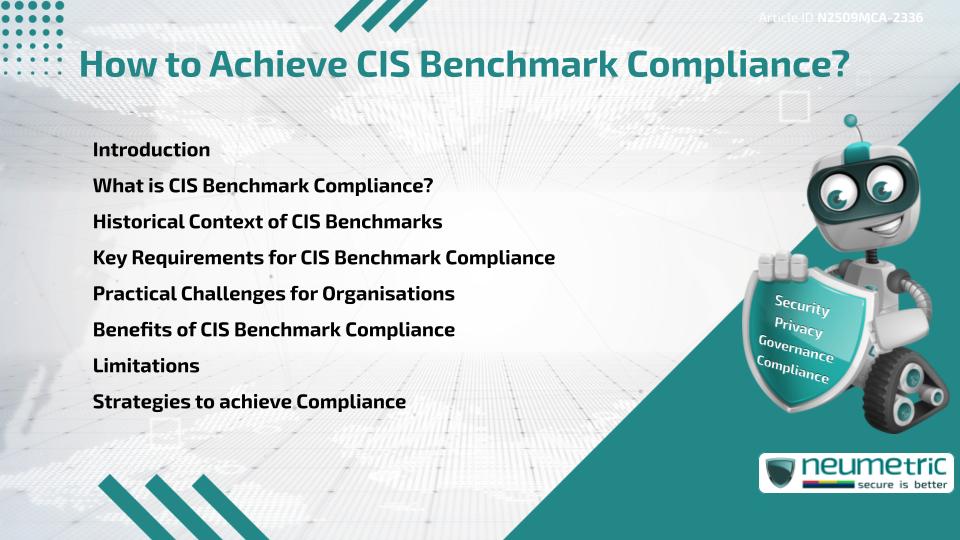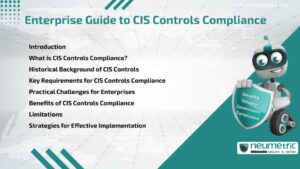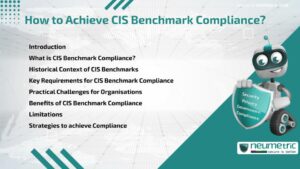Table of Contents
ToggleIntroduction
CIS Benchmark Compliance is a widely adopted Standard that helps organisations strengthen CyberSecurity by following Secure Configuration Guidelines. Developed by the Center for Internet Security [CIS], these Benchmarks cover Operating Systems, Applications & Cloud Environments. For Enterprises, achieving Compliance reduces Risks, ensures consistency & demonstrates strong Governance.
What is CIS Benchmark Compliance?
CIS Benchmark Compliance refers to the alignment of IT Systems with Best Practice Security Configurations defined by CIS. These Benchmarks are consensus based, developed by Experts across Government, Industry & Academia. They help organisations harden Systems against Vulnerabilities while providing a measurable Framework for Audits & Monitoring.
Historical Context of CIS Benchmarks
The CIS Benchmarks were first introduced in the early 2000s to address Gaps in System Security Configurations. Before their introduction, organisations lacked Standardised Guidelines for hardening Systems. Over time, CIS Benchmarks have expanded to cover Databases, Cloud Platforms & Network Devices. Today, they are referenced by Regulatory Frameworks such as NIST & ISO 27001.
Key Requirements for CIS Benchmark Compliance
To achieve Compliance, organisations must:
- Identify relevant Benchmarks for Systems & Applications in Scope
- Configure Systems according to CIS Guidelines (e.g., Password Policies, Firewall Rules)
- Document deviations with justification where Benchmarks cannot be applied
- Regularly Audit Systems to ensure ongoing Compliance
- Integrate Benchmarks into broader Governance & Risk Management Frameworks
Detailed Resources are available from the Center for Internet Security.
Practical Challenges for Organisations
Achieving CIS Benchmark Compliance is not without difficulties. Large Enterprises may struggle to apply Benchmarks across diverse IT Environments. Strict Configurations may disrupt business processes or impact performance. Smaller organisations may lack Tools or Expertise to Automate Compliance monitoring, making manual Audits Resource intensive.
Benefits of CIS Benchmark Compliance
Despite challenges, Compliance delivers several benefits:
- Stronger protection against common Cyberattacks
- Alignment with Industry & Regulatory Standards
- Easier Audits & Simplified reporting for Compliance Frameworks
- Improved trust with Customers & Partners
- Lower long term costs by reducing Vulnerabilities & Incidents
Limitations
Some critics argue that CIS Benchmarks can be too rigid, limiting flexibility for unique business needs. Others suggest that not all Benchmarks are Practical in Real-world Environments, leading to justified deviations. Additionally, Compliance alone does not guarantee complete Security, it must be part of a broader CyberSecurity strategy.
Strategies to achieve Compliance
Organisations can strengthen their approach by:
- Conducting a Gap Assessment to identify Non-compliant Systems
- Using Automated Tools to apply & monitor Benchmark Configurations
- Training IT staff to balance Security & Operational needs
- Documenting exceptions & ensuring compensating Controls
- Leveraging Frameworks from ENISA, OECD & World Bank for Governance alignment
Takeaways
CIS Benchmark Compliance provides a Practical Roadmap for hardening Systems & Reducing Risks. By integrating Benchmarks into Security Practices & Governance, organisations can strengthen resilience, simplify Audits & Build Stakeholder confidence.
FAQ
What is CIS Benchmark Compliance?
It is the alignment of IT Systems with secure Configuration Guidelines defined by the Center for Internet Security.
Why is it important for organisations?
It reduces Risks, simplifies Audits & Aligns with Global Regulatory Standards.
What challenges exist in achieving Compliance?
Challenges include System diversity, Resource constraints & balancing Security with Operations.
Does Compliance guarantee complete Security?
No, but it significantly reduces Vulnerabilities when combined with broader CyberSecurity measures.
How can organisations achieve Compliance effectively?
By using Automated Tools, Training Staff & Documenting exceptions while following CIS Guidelines.
References
- Center for Internet Security
- NIST CyberSecurity Framework
- ISO 27001 – Information Security
- ENISA – European Union Agency for CyberSecurity
- OECD Privacy Guidelines
Need help for Security, Privacy, Governance & VAPT?
Neumetric provides organisations the necessary help to achieve their CyberSecurity, Compliance, Governance, Privacy, Certifications & Pentesting needs.
Organisations & Businesses, specifically those which provide SaaS & AI Solutions in the Fintech, BFSI & other regulated sectors, usually need a CyberSecurity Partner for meeting & maintaining the ongoing Security & Privacy needs & requirements of their Enterprise Clients & Privacy conscious Customers.
SOC 2, ISO 27001, ISO 42001, NIST, HIPAA, HECVAT, EU GDPR are some of the Frameworks that are served by Fusion – a SaaS, multimodular, multitenant, centralised, Automated, CyberSecurity & Compliance Management System.
Neumetric also provides Expert Services for technical Security which covers VAPT for Web Applications, APIs, iOS & Android Mobile Apps, Security Testing for AWS & other Cloud Environments & Cloud Infrastructure & other similar scopes.
Reach out to us by Email or filling out the Contact Form…





